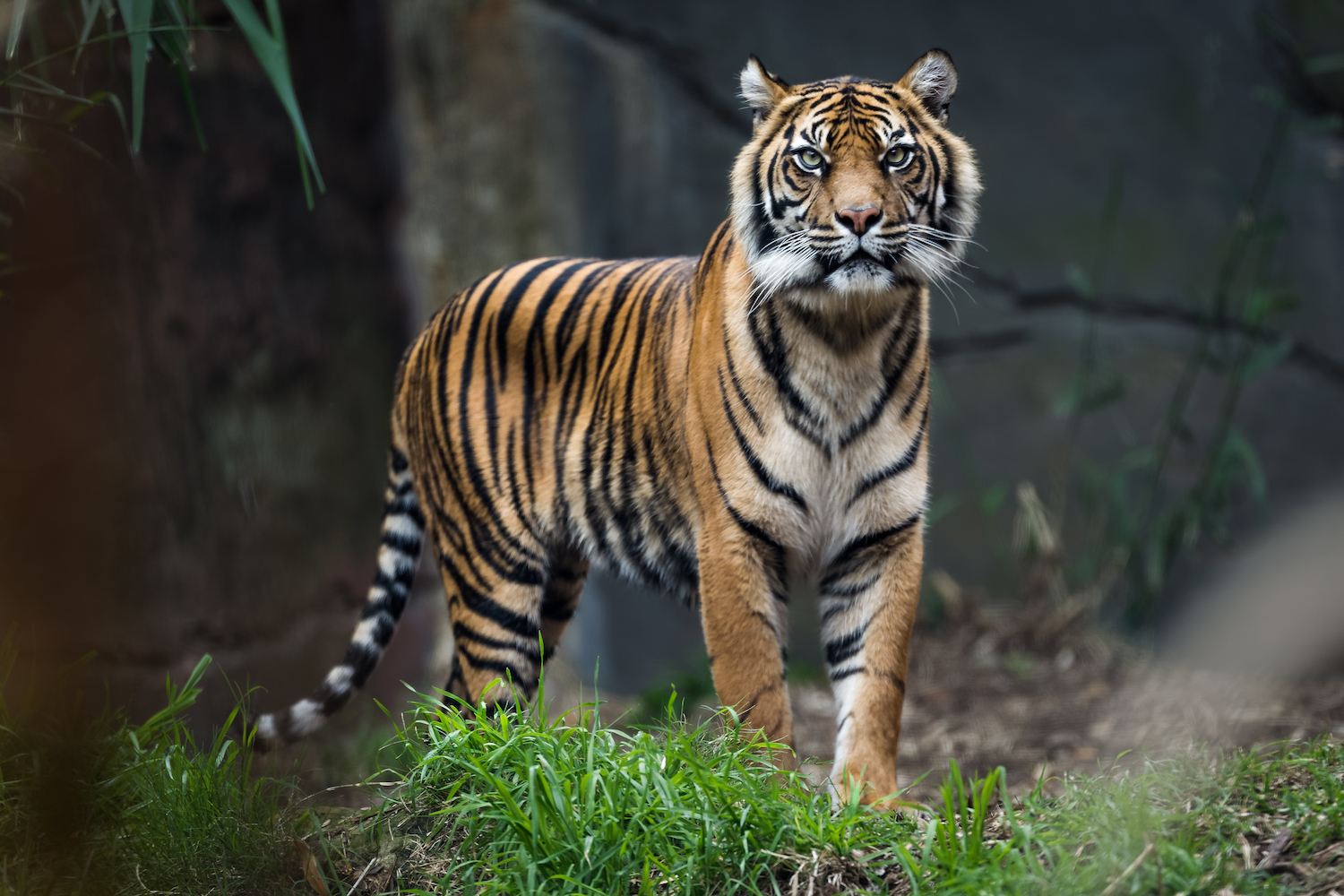Tiger Shark Life Cycle When Its a Baby Tiger Shark Life Cycle
Tigers: The Largest Cats in the Earth

Tigers are the largest felines in the globe and as such, many cultures consider the tiger to exist a symbol of strength, backbone and dignity. The tiger is one of the twelve Chinese zodiac animals, and those built-in in the "Year of the Tiger" are thought to be brave, competitive and cocky-confident.
However, because hunting them is also a sign of bravery in some cultures, tigers are endangered. Tigers are hunted for their meat, pelt and body parts that are used in folk remedies. To make matters worse, these great cats have lost well-nigh of their habitat due to logging, road building and development, according to All Almost Wildlife. Experts estimate there are no more 3,200 tigers left in the wild.
Exercise all tigers have stripes?
Most tigers have the characteristic orange fur with black or brown stripes, simply these markings vary between subspecies. For example, the very large Siberian tiger has pale orangish fur with few stripes, while the smaller Sumatran tigers in the Sunda Islands have night, thickly striped fur.
No two tigers have the same markings, and their stripes are as individual equally fingerprints are for humans. In the wild, a tiger's stripes are important for survival, as they human activity as camouflage, actualization as moving shadows in long grass and in trees, according to National Geographic.
The white Bengal tigers seen in some zoos are the consequence of a recessive gene, and are non albinos. In fact, it's unlikely that true albino tigers (with pink eyes) exist. Some historical reports item tigers with black fur and tan stripes, caused by excessive pigmentation, but these accounts are extremely rare.
On the backs of each ear, tigers have a white spot of fur, called ocelli, according to Tigers.org. It's probable the spots act as imitation optics and they may as well help tigers communicate with 1 another.
A tiger's hind legs are longer than its front legs, assuasive it to bound up to 32.five feet (10 meters), according to Sea Globe. Tiger claws are upwardly to 4 inches (10 centimeters) long, and are used to grab and hold onto their casualty.
The largest tiger subspecies, the Siberian, likewise called Amur, are 10.75 feet (iii.3 chiliad) long and weigh up to 660 pounds (300 kilograms), according to National Geographic. The smallest tiger is the Sumatran, which weighs 165 - 308 pounds (74 - 139 kg), co-ordinate to the Globe Wild fauna Fund (WWF). Tigers also have very long tails, which tin can add effectually iii feet (one m) to their overall length, according to Bounding main World.
Where tigers alive and what they eat
Wild tigers live in Asia. Larger subspecies, such as the Siberian tiger, tend to alive in northern, colder areas, such as eastern Russia and northeastern Red china. Smaller subspecies live in southern, warmer countries, such as Bharat, Bangladesh, Nepal, Kingdom of bhutan, Myanmar, Lao people's democratic republic, Kingdom of cambodia, Vietnam, Malaysia and Indonesia.
Depending on the subspecies, tigers live in a variety of environments, including arid forests, flooded mangrove forests, tropical forests and taiga (a cold wood with coniferous trees), according to the San Diego Zoo.
All tigers are carnivores. Well-nigh of a tiger's diet consists of large casualty, such as pigs, deer, rhinos or elephant calves. To kill their prey, tigers clamp downwards on the animal'south neck with their jaws and suffocate the animal. The tiger's canine teeth take force per unit area-sensing nerves, so it knows exactly where to deliver a fatal bite to its casualty, co-ordinate to the WWF. Though tigers are fierce hunters, they are no strangers to failure, as they are successful in but ten% of their hunts, co-ordinate to National Geographic.

The tiger life
Tigers are solitary creatures; they like to spend most of their fourth dimension lonely, roaming their massive territories looking for food. According to the San Diego Zoo, the Siberian tiger has the largest range; its territory spans more than iv,000 square miles (10,000 square km). Tigers mark their territory past spraying a mix of urine and scent gland secretions onto trees and rocks. They besides scratch marks into trees with their claws.
Tiger babies are born helpless. At nascency, a cub weighs two.2 pounds (ane kg), and a female person may accept as many equally seven cubs at a time, according to the San Diego Zoo. Around half of all cubs don't live beyond the age of two, according to WWF. The mother must leave the cubs while she hunts, leaving them open up to other predators. Most tiger mothers are unable to kill enough prey to feed a big litter, and so some cubs may die of starvation.
At just viii weeks old, tiger cubs are ready to learn how to hunt and go out on hunting expeditions with their mother. At 2 years onetime, the cubs will set out on their own, and their mother volition be ready for some other set of cubs. In the wild, tigers typically live 10 to 15 years, according to Smithsonian's National Zoo.
Classification/taxonomy
For many years, scientists classified tigers into 9 subspecies: vi living subspecies and 3 extinct ones. Just in contempo years, some researchers have challenged the traditional classification. A 2015 study published in the journal Science Advances argued that at that place are simply two subspecies of tigers.
However, a study published in the periodical Current Biology in 2018 presented genomic show supporting vi genetically singled-out subspecies of tigers:the Bengal tiger (Panthera tigris tigris), the Amur tiger (P.t. altaica), the South Prc tiger (P.t. amoyensis), the Sumatran tiger (P.t. sumatrae), the Indochinese tiger (P.t. corbetti), and the Malayan tiger (P.t. jacksoni).
The Javan tiger was last recorded in the 1970s, the Caspian tiger was lost in the 1950s, and the Bali tiger became extinct in the 1930s, according to Panthera, a wild-cat conservation arrangement.

Conservation condition
There are more tigers in captivity than there are in the wild. According to the WWF, there are near 5,000 captive tigers in the United States lonely, simply there are fewer than 3,200 tigers in the wild.
The International Union for the Conservation of Nature's (IUCN's) Red List of Threatened Species categorizes the Amur/Siberian, Indochinese and Bengal tigers as endangered, and the Sumatran, Malayan and South China Tigers as critically endangered. Most remaining tigers live on wildlife refuges to protect them from poachers.
Poaching is past far the biggest threat facing tigers today. Illegal need for tiger basic (used in tonics and medicines), tiger peel (seen every bit a status symbol) and other body parts, is driving the killing and trafficking, which has had an overwhelming touch on tiger populations and resulted in localized extinctions, according to Save Wild Tigers. The continued demand for tiger parts is pushing the species closer and closer to extinction.
In addition to the threat of poaching, but seven% of the tiger's original range remains due to human agriculture, logging, settlements and roads.
Boosted resources:
- Bank check out the Tiger Cam at San Diego Zoo Safari Park.
- Learn more most tiger conservation efforts at the Wildlife Conservation Society.
- Find out the true story of Machli, the World'southward Nigh Famous Tiger from National Geographic.
This commodity was updated on Jun. four, 2019 by Live Science Contributor Traci Pedersen.
Source: https://www.livescience.com/27441-tigers.html
